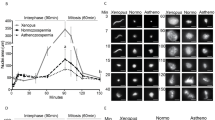Abstract
Purpose: In order to develop a better system for support of human sperm function in vitro, we conducted studies to evaluate whether reproductive tract cells are better than non-reproductive tract cells as an adjunt in that regard.
Methods: Human spermatozoa were cocultured with Vero cells, with human oviduct cells and endometrial cells, and without cells (control) for either 1, 4, or 24 hr. Sperm motility was then analyzed with a computer-aided sperm analyzer (CASA-Hamiliton Thron, HTM IVOS Motility Analyzer). Aliquots of spermatozoa incubated for 24 hr were also stained with Hoechst 33258 and FITC-PNA to evaluate the status of acrosome in live cells.
Results: Significant differences (P<0.05) between the oviduct cell and the control groups after 24 hr were evident in the curvilinear velocity (VCL) (81.4±13.4 vs 60.0±14.1 µm/sec) and amplitude of lateral head displacement (ALH) (5.2±0.6 vs 4.1±0.5 µm). The incidence of acrosome reaction of live sperm was significantly higher in the endometrial cell group than in the controls (25.4±9.9 vs 6.6±2.4%;P<0.001).
Conclusions: Coculture with human reproductive tract cells seems to improve some functional parameters of human spermatozoa. Coincubation with such cell lines, especially oviduct cells, might be a feasible approach to optimization of human spermatozoa for assisted fertilization using subfertile or frozen-thawed samples. We think coincubating human spermatozoa with a human reproductive tract cell line, especially oviduct cells, might be a feasible approach in preparing human spermatozoa for assisted fertilization in subfertile and frozen-thawed semen samples.
Similar content being viewed by others
References
Yanagimachi R: Mammalian fertilization.In Physiology of Reproduction, E Knobi, JD Neill (eds). New York, Raven Press, 1988, Vol 1, pp 135–185
Bongso A, Ng SC, Fong CY, Ratnamm SS: Cocultures: A new lead in embryos in embryo quality improvement for assisted reproduction. Fertil Steril 1991;56:179–191
Bongso A, Ho J, Fong CY, Ng SC, Ratnam S: Human sperm function after coculture with human fallopian tubal epithelial cell monolayers: In vitro model for studing cell interactions in early human conception. Arch Androl 1993;31:183–190
Lai YM, Stein DE, Soong YK, Tang YX, Grifo J, Malter HE: Evaluation of Vero cell coculture system for mouse embryos in various media. Hum Reprod 1992;7:276–280
Soong YK, Lai YM, Chang SY, Wang ML, Chang MY, Lee CL: A successful pregnancy after subzonal insertion of epididymal sperm and coculture on Vero cell monolayer. Fertil Steril 1993;59:1308–1310
Chen CS, Chu SH, Soong YK, Lai YM: Epididymal sperm aspiration with assisted reproductive techniques: Difference between congenital and acquired obstructive azoospermia? Hum Reprod 1995;10:1104–1108
Guelrin JF, Ouhibi N, Regnier-Vigouroux G, Menezo Y: Movement characteristics and hyperactivation of human sperm on different epithelial cell monolayers. Int J Androl 1991;14:412–422
Wetzels AMM, Bastiaana BA, Goverde HJM, Janssen HJ, Rolland R: Vero cells stimulate human sperm motility in vitro. Fertil Steril 1991;56:535–539
Pearlstone AC, Chan SYW, Tucker MJ, Wiker SR, Wang C: The effects of Vero (Green monkey kiney) cell coculture on the motility patterns of cryopreserved human spermatozoa. Fertil Steril 1993;59:1105–1111
Chen HF, Ho H-N, Chen SU, Lien YR, Chao KH, Lin HR, Huang SC, Lee TY, Yang YS: Co-culture with Vero cell monolayer maintains the motility of asthenozoospermic semen samples Hum Reprod 1994;9:1276–1280
Bongso A, Fong CY, Ng SC, Ratnam SS: Human embryonic behavior in a sequential human oviduct-endometrial coculture system. Fertil Steril 1994;60:976–978
Fusi FM, Vigano P, Daverio R, Busacca M, Vignali M: Effects of the coculture with human endometrial cells on the function of spermatozoa from subfertile men. Fertil Steril 1994;61:160–167
Kervancioglu ME, Diahanbahch O, Aitken RJ: Epithelial cell coculture and the induction of sperm capacitation. Fertil Steril 1994;61:1103–1108
Goldman EE, Ellington JE, Farrell PB, Foote EH: Use of fresh and frozen-thawed bovine oviduct cell for acrosomal reacting fresh and frozen thawed bull sperm in vitro. Theriogenology 1991;35:204–223
Ouhibi N, Hamidi J, Guillaud J, Menezo Y: Co-culture of 1-cell mouse embryos on different cell supports. Hum Reprod 1990;5:734–737
Author information
Authors and Affiliations
Rights and permissions
About this article
Cite this article
Lai, Y.M., Chang, F.H., Lee, C.L. et al. Coculture of human spermatozoa with reproductive tract cell monolayers can enhance sperm functions better than coculture with vero cell monolayers. J Assist Reprod Genet 13, 417–422 (1996). https://doi.org/10.1007/BF02066175
Received:
Accepted:
Issue Date:
DOI: https://doi.org/10.1007/BF02066175




